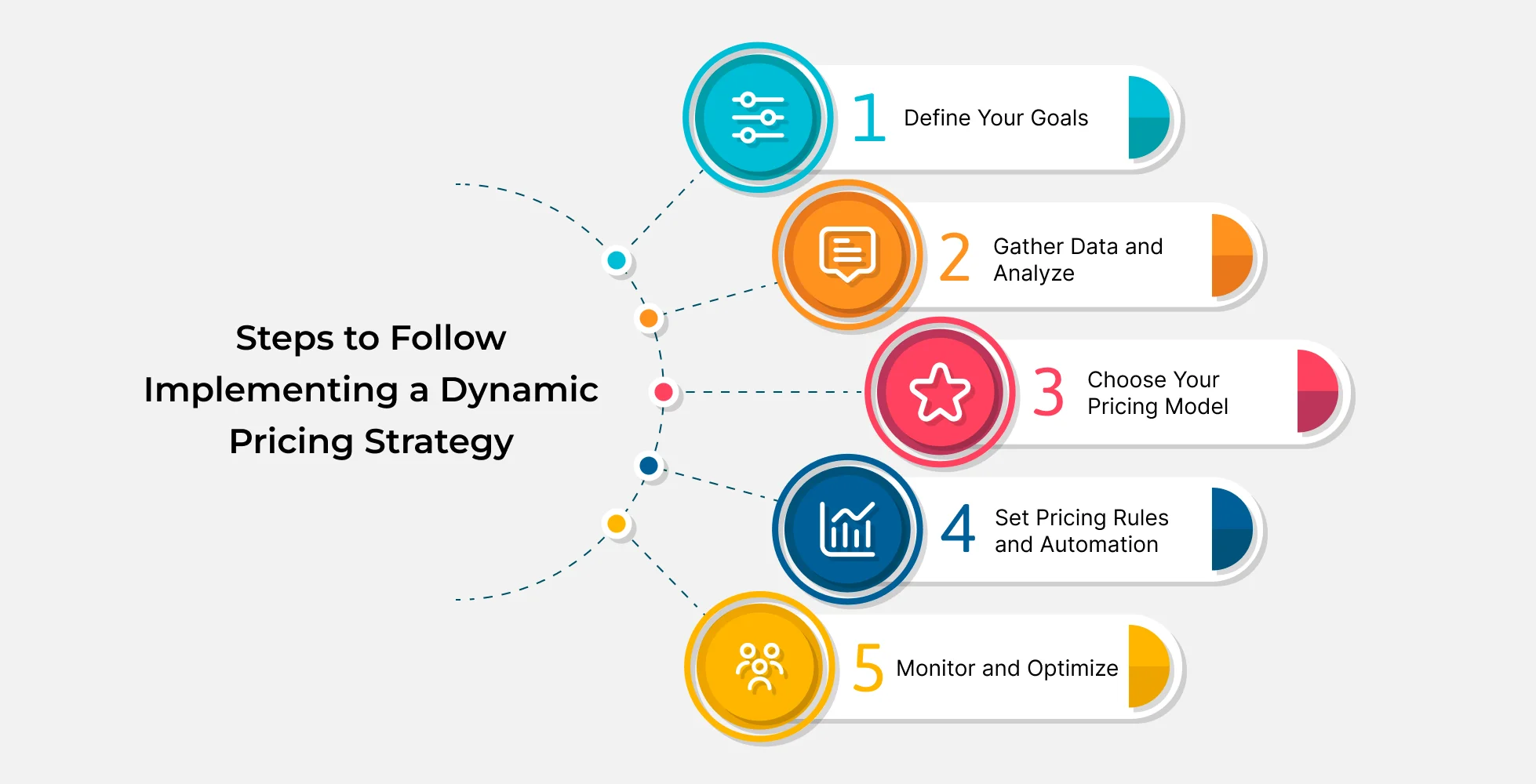Are you missing out on profits? Do you feel pressured by ever-changing competitor pricing? Do you want to personalize the consumer experience? Tired of relying heavily on static pricing models? Businesses often struggle with questions like these and we have just the solution for you—dynamic pricing.
In this comprehensive guide, we’ll delve into the world of dynamic pricing—explore its definition, types, models, benefits, and more. Let’s dive in!
What is Dynamic Pricing?
Dynamic pricing is like having a superpower for your prices. Imagine it adjusts automatically, based on what’s hot, who your competitors are, and how much you have in stock. Unlike static pricing, which stays the same, the dynamic pricing method enables you to win in real time. This means more profit for you! This guide will explore how dynamic pricing works and why it’s a game-changer for businesses.
Core Principles of Dynamic Pricing Strategy
- Demand-Driven Pricing: At its heart, dynamic pricing management revolves around the concept of supply and demand. Prices fluctuate based on customer demand for a particular product or service. During periods of peak demand, prices rise, reflecting the customer’s willingness to pay a premium for immediate access. Conversely, prices dip during low-demand periods to incentivize purchases and clear inventory.
- Real-Time Adjustments: Static pricing? Outdated. Dynamic pricing adjusts prices on the fly, reacting to competitors, trends, and customer behavior. It’s like having a pricing superpower that maximizes profit in real time. This guide unlocks the secrets of dynamic pricing and why it’s a game-changer for businesses.
- Data-Driven Decisions: Dynamic pricing thrives on data. Businesses use fancy math models to crunch sales history, competitor prices, and how customers buy. This lets them predict what will sell and set the best prices to make the most money.
Factors Influencing Price Adjustments
- Demand Fluctuations: Seasonal trends, holidays, and unexpected events, all significantly impact demand. Dynamic pricing software allows businesses to adjust prices accordingly. For instance, hotels might raise prices during peak travel seasons and offer discounts during off-seasons.
- Inventory Levels: When inventory levels are high, businesses might resort to dynamic pricing to clear out stock. This is often seen with perishable items or products nearing their end-of-life cycle. Conversely, limited-edition or in-demand products might command higher prices due to lower inventory levels.
- Competitor Pricing: Businesses monitor competitor pricing and adjust their own prices dynamically to remain competitive. This might involve matching competitor discounts or strategically pricing products just below the competition.
- Customer Segmentation: Dynamic pricing enables businesses to play favorites with their prices. A travel site can charge students less for flights than business travelers because they might be more flexible. This way, they offer the best price for each customer and still make money.
Types of Dynamic Pricing
Dynamic pricing isn’t a one-size-fits-all strategy. Businesses choose from various approaches to adjust prices based on what works best. This enables them to react to changing markets and customer behavior to keep their pricing sharp. Let’s look at some of the types of dynamic pricing strategies:
This involves adjusting prices on peak hours, weekends, holidays, or weather patterns. Prices may increase during periods of high demand and decrease during off-peak times.
1. Segment-Based Pricing
Segment-based pricing involves setting different prices for different customer segments. This includes demographics, purchasing behavior, loyalty status, or geographic location.
2. Event-Based Pricing
Event-based pricing involves adjusting prices in response to specific events or occasions. This includes concerts, sporting events, festivals, or holidays. Prices may increase or decrease depending on the anticipated demand associated with the event.
3. Competitor-Based Pricing
Competitor-based pricing involves monitoring and adjusting prices in response to competitor pricing strategies. Prices may be set lower than competitors to attract customers or matched to maintain competitiveness.
4. Demand-Based Pricing
Demand-based pricing involves setting prices based on the demand of products or services. Prices may increase during periods of high demand or scarcity and decrease when demand is low to stimulate sales.
5. Location-Based Pricing
Location-based pricing involves adjusting prices based on the geographic location of the customer or the point of sale. Prices may vary depending on factors such as local market conditions, economic factors, or regulatory requirements.
6. Discount-Based Pricing
Discount-based pricing involves offering discounts or promotions based on specific conditions, such as bulk purchases, membership status, referral programs, or seasonal sales events.
These dynamic pricing types provide businesses with a range of strategies to optimize pricing decisions and maximize revenue in response to changing market dynamics.
Dynamic Pricing Models
Dynamic pricing models are your secret weapon for mastering this pricing strategy. These models lay out the steps, the algorithms (think fancy math!), and the decision-making process to adjust prices quickly. React to what the market throws your way and what customers are looking for, keeping your pricing sharp.
Algorithmic Pricing Model
This model uses algorithms and data analytics to analyze factors like demand, competitor pricing, inventory levels, and customer behavior. It determines optimal prices in real time. Algorithms refine pricing strategies using machine learning techniques from feedback and performance metrics.
Revenue Management Model
Revenue management models adjust prices based on demand elasticity and capacity constraints. These models are commonly used in industries such as hospitality, airlines, and entertainment, where perishable inventory and limited capacity necessitate dynamic pricing strategies.
Price Optimization Model
Price optimization models are your profit calculators. They use advanced math to figure out the best prices that make you the most money. They consider how much people are willing to pay, how much you’ll sell, and your costs. This way, you balance making money, growing your market share, and keeping customers happy.
Dynamic Discounting Model
Dynamic discounts are your deal-making charm. You offer sweet deals based on how much someone buys, how often they order, or who they are. This gets them buying more, keeps them happy, and enables you to sell more stuff and make more money. Win-win-win!
Use Dynamic Pricing in Retail and E-Commerce
Dynamic pricing is rapidly transforming the retail and e-commerce landscape. Let’s explore how it goes beyond basic price optimization to create a more competitive, efficient, and customer-centric shopping experience.
- Optimizing the Customer Journey: Dynamic pricing goes beyond simply reacting to competitor prices. E-commerce platforms leverage customer behavior data to personalize pricing. Imagine a scenario where a customer frequently browses a specific brand of headphones. Dynamic pricing algorithms might subtly increase the price of those headphones over time while keeping competitor brands at a slight discount. This strategy capitalizes on the customer’s established interest while remaining competitive.
- Maximizing Revenue Across Channels: Dynamic pricing isn’t restricted to online stores. Brick-and-mortar retailers utilize it for targeted in-store promotions. Imagine a scenario where a store identifies slow-selling items through point-of-sale data. Electronic shelf labels can be dynamically updated to display targeted discounts on those items, incentivizing immediate purchases and preventing lost sales.
- Enhanced Demand Forecasting: By analyzing historical sales data alongside weather patterns or upcoming events, businesses set prices that anticipate future demand fluctuations. For example, a sporting goods store might strategically raise prices on athletic wear leading up to a major marathon, capitalizing on the surge in demand.
- Transparency and Building Trust: You need to ensure transparency in your pricing strategies. This could involve displaying price change history or offering clear explanations for dynamic pricing. Building trust with customers is key to fostering long-term loyalty in this evolving pricing landscape.
💡Fact
According to a report by Salesforce, 72% of customers have switched brands just for a better deal.
Businesses today require better ways to optimize prices. Even personalizing them to gain and maintain customer loyalty toward their brand. Dynamic pricing empowers retailers and e-commerce businesses to move beyond static pricing models. By leveraging data and algorithms, businesses create a dynamic and responsive pricing strategy that optimizes revenue, streamlines inventory management, and personalizes the customer journey, ultimately shaping the future of retail.
Dynamic Pricing Examples
- Retail Industry: Retailers are using dynamic pricing to win in today’s competitive market. This means changing prices online and in-store based on what’s hot, competitor prices, and how customers shop. For example, online stores can offer personalized discounts to customers based on their past purchases. Brick-and-mortar stores can adjust prices to match competitors or clear out extra stock. The goal? Stay competitive, sell more, and adapt to a market that’s always changing.
- Airline Industry: They constantly adjust flight prices based on how many seats are left, how close it is to departure, and how many people want to fly that route. This means you might find cheaper fares for less popular times to fly, or airlines might adjust prices to match competitors. It’s all about maximizing revenue and keeping those planes full.
- Hotel Industry: Hotels implement dynamic pricing strategies to optimize room rates. They factor prices based on occupancy levels, seasonal demand, and local events. For instance, hotels may raise prices during peak tourist seasons or major events in the area and lower them during periods of low demand to attract more guests.
- Online Ticketing Platforms: Ticketing platforms like Ticketmaster use dynamic pricing strategies to adjust ticket prices for concerts, sports events, and shows based on demand and availability. Prices may vary depending on factors such as seat location, time until the event, and historical sales data. Dynamic pricing enables ticketing platforms to maximize revenue while ensuring that tickets are priced competitively.
- Ride-Sharing Apps: Apart from Uber, other ride-sharing apps like Lyft also employ dynamic pricing. They adjust fares during times of high demand or low driver availability. For example, prices may increase during rush hours, special events, or inclement weather to encourage more drivers to be on the road and meet passenger demand.
Benefits of Dynamic Pricing
- Revenue Optimization: Enable businesses to maximize revenue by adjusting prices based on demand and market conditions.
- Inventory Optimization: Enable businesses to manage inventory more effectively by aligning prices with inventory levels.
- Competitive Advantage: Enables businesses to stay competitive by adjusting prices dynamically in response to competitor pricing and market trends.
- Personalized Pricing: Allows businesses to offer personalized discounts and promotions tailored to individual customer preferences, increasing customer satisfaction and loyalty.
- Market Adaptability: Enables businesses to adapt quickly to changing market conditions and consumer preferences, maintaining relevance in the market.
- Real-Time Insights: Provides valuable insights into consumer behavior and market trends, facilitating data-driven decision-making.
- Increased Sales: Increase in sales by offering discounts during off-peak times or targeting price-sensitive customers.
- Improved Customer Satisfaction: Customers may perceive dynamic pricing as fairer when prices are adjusted based on demand, leading to improved satisfaction.
- Enhanced Price Discrimination: Allows businesses to implement price discrimination strategies by offering different prices to different customer segments.
- Promotion Effectiveness: Enables businesses to test and optimize pricing strategies in real time, maximizing the effectiveness of promotions and discounts.
Cons of Dynamic Pricing
- Potential Consumer Backlash: Dynamic pricing may lead to consumer distrust if customers perceive price changes as unfair or discriminatory.
- Complexity: Implementing and managing dynamic pricing strategies could be complex and require specialized expertise.
- Margin Erosion: Rapid price adjustments may lead to erosion of profit margins, especially if not carefully managed.
- Price Perception: Consumers may perceive frequent price changes as indicative of unreliable pricing or product quality.
- Legal and Regulatory Risks: Dynamic pricing strategies must comply with legal and regulatory requirements, including anti-discrimination laws and pricing regulations.
- Overdependence on Data: Dynamic pricing relies heavily on data and analytics, which leads to over-reliance on technology and potential data privacy concerns.
- Customer Confusion: Frequent price changes may confuse customers and undermine their trust in the pricing structure.
- Lack of Transparency: Customers may feel that dynamic pricing lacks transparency, leading to frustration and dissatisfaction.
- Brand Perception: Inconsistent pricing may harm a company’s brand perception and reputation in the market.
- Resistance from Traditional Customers: Some customers may resist dynamic pricing strategies, preferring fixed or traditional pricing models.
How Do You Implement a Dynamic Pricing Strategy?
 Step 1: Define Your Goals: What do you aim to achieve? Increase revenue, optimize inventory, or gain market share? Clearly defined goals guide your pricing strategy.
Step 1: Define Your Goals: What do you aim to achieve? Increase revenue, optimize inventory, or gain market share? Clearly defined goals guide your pricing strategy.
Step 2: Gather Data and Analyze: Data is the fuel for dynamic pricing. Collect information on customer behavior, competitor pricing, historical sales trends, and market demand fluctuations. Leverage analytics tools to identify patterns and trends.
Step 3: Choose Your Pricing Model: Different models suit different goals. Time-based pricing adjusts prices based on peak hours or seasons. Dynamic pricing adjusts based on real-time demand fluctuations. Experiment to find the best fit.
Step 4: Set Pricing Rules and Automation: Establish clear rules for price adjustments based on your chosen model and data insights. Utilize automation tools to streamline dynamic price updates across platforms.
Step 5: Monitor and Optimize: Dynamic pricing is an ongoing process. Regularly monitor the impact of your pricing strategy on your goals. Analyze results, refine your rules, and adapt to changing market conditions.
Conclusion
Dynamic pricing is a powerful tool for retailers and e-commerce businesses seeking to maximize revenue, optimize inventory, and stay competitive in today’s market. By understanding its principles, types, applications, and best practices, you harness the full potential of dynamic pricing to drive profitability and success in your business.
Take the Next Step
Embrace the dynamic pricing revolution and stay ahead of the curve!
Maximize profits and engage your customers with dynamic price optimization strategies. Leverage artificial intelligence- and machine learning-powered price optimization solutions to rise above your competition.
Frequently Asked Questions
Isn't dynamic pricing unfair to customers?
Dynamic pricing can be perceived as unfair if not implemented transparently. The key is to ensure customers understand the rationale behind price adjustments.
How can I implement dynamic pricing in my small retail business?
Implement dynamic pricing by analyzing demand, competitor pricing, and customer behavior. Adjust prices accordingly to maximize revenue.
What are some ethical considerations for using dynamic pricing?
Ethical considerations for dynamic pricing include transparency, fairness, and avoiding price discrimination based on customer demographics or behavior.





